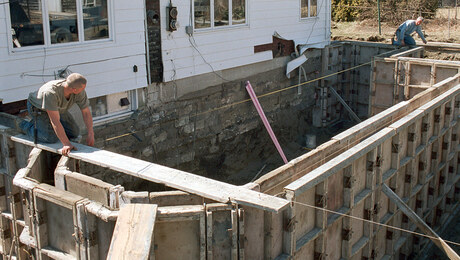quick question, I’m working on a house with old (1920’s) plumbing. there is a section of cast iron drain pipe that I need to un-couple. I understand they are probably soidered together with lead, so I’m guessing the method of attack is to heat the bee-geebers out of the thing with a torch and twist it apart.
Am I on the right track here, and are there any safety concerns with sewer gasses that might be present in the pipe and acetalyne torches.
thanks,
st


















Replies
I have always had good luck taking a screwdrive, pretty good sized flat blade and pounding it through the layer of lead. The lead is usually only 1/2" thick or so. Once through you will plunge into the okum which is packing. Once through the lead you can usually pry out the lead with no heat and then remove the packing and the pipes will fall apart. Putting them back together is another story. DanT
If you are removing the cast iron & replacing it with PVC, you're gonna think I'm nuts but cast iron is brittle. If you smack the bell with a hammer it will crack, and the rest is history...the entire section of pipe will be gone in 5 minutes.
You might have to smack it pretty hard, though, especially if it's not firmly supported and flexes under the blows.
did one a couple months ago...it was horizontal, and took my acetylene torch and aimed it into the slot where the lead was on top of the okum. It all ran out and it came apart easily...put a rubber insert in it and attached to abs and was done...
You might be better off just smashing it, as suggested, but only if you don't have to save part of it. Otherwise, you could cut it and tie in with a rubber and stainless no-hub connector. To cut the pipe, you can rent a pipe snapper, or get a special carbide blade for your sawzall.
It seems unlikely that trying to melt the lead is worth the hassle.
Al Mollitor, Sharon MA
appreciate all the input from everyone. I'm not sure if smashing it would be the best option.
The project I working on is a rental house (got to stop doing those). Lady called me out to look at replaceing a few rotten peices of trimwork, turned out that the small 2 story addition that contained the bathroom for the downstairs rental unit was completed rotted, and I mean completly rotted.
Anyway, a month and a half later, the old additon is in the dumpster, and we now have a bathroom that is in the downstairs area, verses the old one that you had to climb a ladder to get to the toilet (that was how they installed it to get above the street level sewage).
Anyway, I was left with a section of 4" cast iron pipe, complete with toilet flange extending 7 feet high out the side the building. looks like modern art.
there is a coupling just pertruding from the side of the buidling, that's where I wanted to disconnet, since the upstairs sink drain ties in just on the other side of the wall, I'm not sure if breaking the stuff outdoors with a hamer is applicable here. sounds like I'll give the flat head screw driver the first shot at it.
thanks
st
Slight change of subject, but does anyone have any suggestions on repairing leaking connections on these old cast iron lines. Client's house has a long horizontal run with several of the joints leaking. Can I replace the lead with something else, or just repair/ replace the solder?
To repair a leak you tighten the lead by hammering the lead with the right calking iron. Or if you can find lead wool, looks like steel wool only lead, this can be hammered into place to stop a leak without going the molten lead route.
hitting it with the hammer did the magic trick. busted it out right up to the coupling. appricate the help from you all.
st.